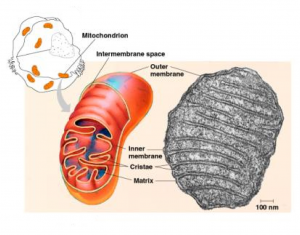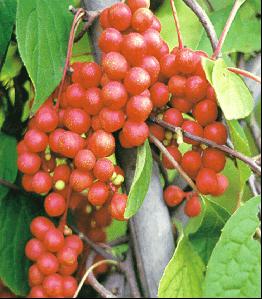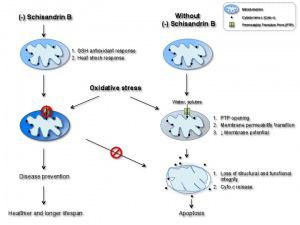Introduction
This is Part 2 of a 3-part series on the quest by scientists to find effective ways to fight skin aging. In our previous article, entitled “What causes skin aging: Making sense of the latest research findings”, we discussed how oxidative damage is regarded in the scientific community as the primary cause of aging, and how mitochondria play a significant role in this by being a major source of free radicals.
Now, scientists have made a breakthrough in fighting the leading cause of skin aging: Schisandrins have been proven to effectively reverse mitochondrial decay.
A recap of our previous discussion
Mitochondrial decay in aging refers to a progressive disruption to mitochondrial structural integrity and functional ability over time. Consequently, cells experience impaired energy production, a decline in normal function, and accelerated free radical generation. This is the phenomenon of cellular aging, which makes the cell more prone to apoptosis, or programmed cell death – much like cell suicide.

Figure 1: Structure of a mitochondrion
Skin aging – the signs of which are commonly manifested in wrinkles, fine lines, age spots, loss of suppleness, and deterioration of skin tone – has been proven to involve mitochondrial dysfunction.
The mitochondria–free radical connection
Research has shown that mitochondria are a major source of free radicals. Deteriorating mitochondria instigate a vicious cycle of exacerbated oxidative stress. Consistent with these findings is the concept that “manipulating the signaling pathways that regulate cellular antioxidant defense” and “controlling the intracellular levels of free radicals” is preferred over “altering individual antioxidant components by extrinsic supplementation”.
In simpler terms, this means that it may be more effective to combat aging by treating the source of free radical production rather than by “cleaning up” free radicals after they are generated. This theory is supported by recent studies that have found that scavenging free radicals through the supplementation of certain antioxidants could be ineffective or even harmful in the long run.[i] [ii]
The role of Schisandrin B in skin-related mitochondrial decay
There has been a substantial amount of research on remedies to combat mitochondrial decay as an effective means of mitigating the aging process. Particularly noteworthy is the research conducted by Dr. Bruce Ames (UC Berkeley) and Dr. Tory Hagen (Oregon State University), who investigated the effects of acetyl-L-carnitine and alpha-lipoic acid on improving the functional capability of mitochondria.
Over the past few decades, the pharmacological activities of Schisandrin B, an active ingredient isolated from Fructus Schisandrae (commonly known as the Schisandra berry), have been studied extensively. Research conducted at RK-Lab at the Hong Kong University of Science and Technology have demonstrated the protective effect of Schisandrin B on free radical-induced damage in various vital organs, including the heart, liver, kidney, and brain.

Figure 2: Fresh Schisandra berries
Research has shown that Schisandrin B is able to simultaneously:
- enhance mitochondrial functional ability, and
- increase natural mitochondrial antioxidant capacity.
These are clear indications that this natural compound is effective in mitigating further mitochondrial decay, successfully defeating this leading cause of skin aging.
In addition, Schisandrin B has been proven to be able to induce the expression of heat shock proteins, endogenous protein molecules essential in cellular protection against various stressful stimuli. The expression of heat shock proteins is believed by many in the scientific community to be another crucial biochemical mechanism for fighting aging.
The latest research
Recent research has found a stereoisomer of Schisandrin B, (−)Schisandrin B, to be even more potent in enhancing mitochondrial functional ability and in boosting the innate antioxidant capacity of mitochondria.

Figure 3: Comparison of a cell treated with (−)Schisandrin B vs. a cell with no treatment
(−)Schisandrin B protects cells against oxidative stress, thereby preventing disease and enabling a healthier and longer lifespan. Without (−)Schisandrin B, cells are vulnerable to oxidative stress. This results in the loss of structural and functional integrity and cyto c release, and ultimately leads to cell death.
Implications for anti-aging skincare
The pharmacological properties of Schisandrin B and (−)Schisandrin B have significant implications for anti-aging skincare, since skin is the largest organ of the human body, and oxidative damage has been recognized as one of the major factors that contribute to skin aging. Wrinkles, fine line, age spots, sagginess, loss of radiance, and many other signs of skin aging are all attributed to oxidative damage.
Studies at RK-Lab at the Hong Kong University of Science and Technology[iii] have validated the beneficial effects of Schisandrin B and (−)Schisandrin B on skin cells and skin tissues. Furthermore, topical formulations using Schisandrin B and (−)Schisandrin B have been clinically tested on human subjects with remarkable anti-aging results.
Schisandrin B and (−)Schisandrin B are the key compounds in Glissandrin™, an active ingredient in anti-aging skincare consisting of natural compounds extracted from the Schisandra berry. This active ingredient has been incorporated into the most advanced anti-aging skincare products, now available from Glissandra™ Skincare Inc.
As the first active ingredient to holistically:
- address mitochondrial decay,
- increase natural cellular antioxidant capability, and
- target other causes of aging,
Glissandrin™ is a breakthrough in the anti-aging skincare industry.
To be continued…
In the next article, the powerful anti-aging properties of Glissandrin™ will be explored in further detail.
For more information
More information on Schisandrin B, (−)Schisandrin B, mitochondrial decay, and theories of aging can be found at these independent websites:
- National Institutes of Health (http://www.nih.gov/)
- PubMed (http://www.ncbi.nlm.nih.gov/pubmed/)
- Natural Standard (http://www.naturalstandard.com/)
[i]
[ii] Vitamins in Aging, Health, and Longevity, David R Thomas; The Division of Geriatric Medicine, Saint Louis University Health Sciences Center, Saint Louis, MO, USA.
[iii] The Hong Kong University of Science and Technology was ranked 35th among research universities worldwide by Times Higher Education in 2009.
